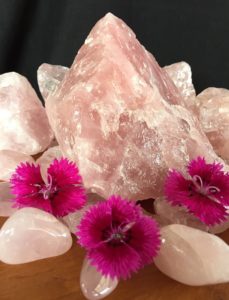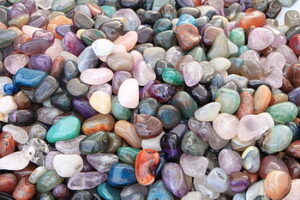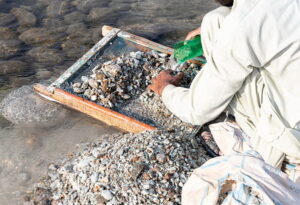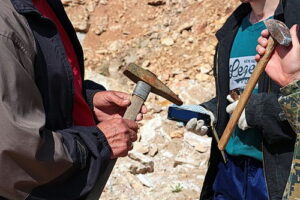
We have previously talked about gem hunting, but we have not discussed the steps as to how to approach the prospecting for gemstones, so let’s get right into how you start your gem-hunting adventure:
Research Your Locations
Different types of gemstones are found in a variety of regions, so it’s important to identify areas where the stones you’re interested in are found.
Start with the Ineternal Gem Society. They can provide you with some of the top locations around the country where you can dig for gemstones.
Make Sure You Have the Right Equipment for Your Gem Search
Depending upon the location you select, they should be able to provide you with the necessary tools for your hunt, most probably for a fee, but you could bring your own equipment as well. That would consist of a pair of gloves, a shovel, a bucket, a screen or sifter, and a magnifying glass. Additionally, when you are there, ask for a gemstone identification guide.
Where to Look for Gems?

Ever gone bird watching?
If yes, then you know that you have to travel to a certain spot of a particular destination to view a specific species of bird. To find the right destination for bird watching, one has to find out the species’ habitat, migration patterns, food choices, etc.
Knowing these things will help you figure out the location where a particular species of bird is likely to be found. You cannot simply wander around the forest in the hope of finding the types you are looking for; it would be nothing more than wasting time.
Experts say that gem hunting is much like bird watching. You most likely will not find minerals dug in the soil outside your home; however, the practical approach is to first research the areas where the gems are naturally found and then use the right technique to access the deposits.
For example, since diamonds are formed as a result of extreme pressure, they are either found deep inside the earth, in areas where various geological processes have pushed the mantle rocks from the depths of the earth to the surface, or alongside the rivers that flow from such areas.
Similarly, if you are looking for malachite, you have to look for it near copper and limestone deposits.
The occurrence of gemstones may also vary across countries, depending upon their geological processes, volcanoes, storms, and earthquakes, as they cause shifts in the tectonic plates and bring the buried bedrock to the surface of the earth.
Methods for Gemstones Mining
From basic to advanced, there are various mining methods. They include:
- Underground Mining
When hunting for your stones is done within the pipe and alluvial deposits, it is called underground mining. The methods used for underground mining are:
- Block caving
- Tunneling
- Chambering
- Open Cast Mining
Open-cast mining uses different techniques. Here removal of the upper layer of rocks is required in order to reach the bedrock, which is buried deep inside the earth that contains the gems. Any of the following methods are used to excavate gems from the deepest layers of the earth:
- Terrace Mining
- Pit Mining
Open-cast mining methods are widely used in various parts of the world including the United States, Sri Lanka, Brazil, and Myanmar. etc.
- Sea Mining
Sea mining, marine or undersea mining, as they are alternatively called, is used in areas where marine deposits are present.
- River Digging
As evident from the name, river digging is performed in and around rivers and lakes to excavate the gems that have been buried in the river soil and rocks naturally, by the water current or geological processes over time. It can further be classified into two types:
- Wet Digging
- Dry Digging
Gem Hunting Tools

As with any other specialized task, you cannot expect to have a successful gem-hunting experience if you don’t have the right tools and equipment.
For example, there is no point in going fishing without a fishing tackle and/or bait. It is highly unlikely to catch a fish with your hands. Similarly, searching for gemstones without the proper gem-hunting tools is nothing more than wasting your time. Tools for gem hunting are easily available at affordable prices, which means that even occasional hunters can easily buy them without exceeding their budgets.

For gem hunting, you would need the following basic tools:
- Shovel
- Rock Hammer
- Magnifying lens
- Bucket and collection bags
- You may need some specialized equipment to excavate some particular types of gems, such as a metal grid frame for screening, a pan for gold, etc
- Permanent markers for labeling
For your safety and comfort:
- Wear comfortable clothes and shoes
- Apply insect repellent and sunblock
- Wear goggles
- A GPS device or map to find your way
- Water
- Hat
- Gloves
- Walkie-Talkies for communication
There is More Than One Method for Gem Hunting
You should research the different methods employed when looking for your precious stones. Some of the most popular are:
- Hydraulic Mining, where jets of water are used to loose the rocks from the dirt,
- River Panning is where you essentially wash away the gravel to find the minerals,
- Open Pit Mining, where you physically remove rocks, possibly in a quarry to search for the gems.
But this just scratches the surface (pun intended). Do some research to find the best method you prefer.
Learn Gemstone Identification
Familiarize yourself with the characteristics and properties of the gemstones you’re hunting for. Look for distinguishing features like color, luster, hardness, and crystal structure. Using a mineral identification guide or app can help determine the gemstones you find.
